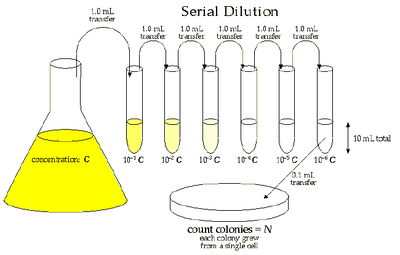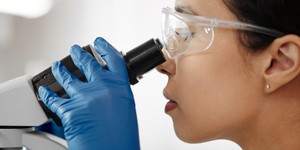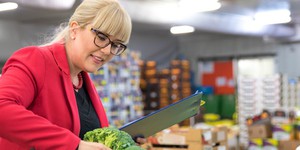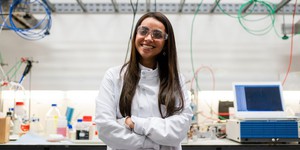Abstract
How does your family thaw and cook meat? Have you ever wondered if it is the safest way? In this practical science project, you can find out and shed light on safe practices in the kitchen by investigating how many viable bacteria are present in samples of meat that have been thawed or cooked using different methods.Summary
Andrew Olson, Ph.D., Science Buddies
Sources
This project is based on:
- Karney-Grobe, S.L., 2004. Meat That's Raw: How Do You Thaw? California State Science Fair Abstract. Retrieved September 12, 2006.

Objective
To determine which method of defrosting meat is safest and which method of cooking kills the most bacteria.Introduction
Which is the safer way to thaw frozen meat: at room temperature or in the refrigerator? For cooking meat safely, is a microwave as good as a conventional oven?
One way to find out is to measure how many viable bacteria are present in samples of meat that have been thawed or cooked by the different methods mentioned above. How do you measure the number of viable bacteria? One way is to homogenize a sample of meat in a blender, dilute the sample, and then plate it on a bacterial culture plate. The plate is then incubated overnight (or longer), and visible colonies of bacteria are then counted. The goal is to dilute the sample sufficiently so that individual bacteria are separated from one another on the plate, meaning that each colony will have arisen from an individual bacteria—referred to as a colony forming unit or CFU.
Typical laboratory cultures have between 106 and 109 bacteria/mL, and for plating bacteria, you typically use a volume of 100 μL (which is the same as 0.1 mL). So if you simply took your sample straight from the culture, you'd expect to have between 105 and 108 (100,000 to 100,000,000) bacteria in your 100 μL sample. Obviously, you would end up with far too many colonies to count! In fact, the plate would be so densely covered that you wouldn't be able to distinguish individual colonies.
To get around this problem, the obvious solution is to dilute the sample. If you wanted to end up counting about 100 colonies per plate, then you'd need to dilute between 1,000– and 1,000,000-fold. It's not practical to make such large dilutions in a single step, so a good way to do this is by using serial dilutions. The diagram in Figure 1, below, illustrates the process. Each tube starts out with 9 mL of sterile water. 1 mL of the bacterial culture solution is added to the first tube, and mixed. This dilutes the bacterial solution by a factor of 10. Then, 1 mL of the solution from the first tube is removed, and added to the 9 mL of sterile water in the second tube. This is another 10-fold dilution, making a 100-fold dilution of the original solution.
 Image Credit: T. Kirkman / Copyrighted
Image Credit: T. Kirkman / CopyrightedA solution is diluted by 90% when 1 mililitre of a solution is added to a beaker that contains 9 mililitres of distilled water. This new beaker now contains 10% of the original solution. When this process is repeated 6 times, the initial solution is diluted by a factor of 1,000,000.
The serial dilutions are continued in a similar manner until the desired final dilution is achieved. In order to calculate how many bacteria were present in the original solution, you count colonies on the plate, and then multiply by the total dilution factor. You can see that it is important to make the volume measurements accurately and reproducibly for this process. Errors in measurement will cause errors in the bacterial count.
In this project, you'll see how you can apply this method to figure out how many viable bacteria there are in samples of meat that have been exposed to different thawing and cooking conditions.
Terms and Concepts
To do this project, you should do research that enables you to understand the following terms and concepts:
- colony forming unit (CFU),
- serial dilution.
Questions
- Why are the samples diluted so many times before plating them on agar?
- What are some potential sources for error in the bacterial counts in this experiment?
- What can you do to minimize those sources of error?
- For more advanced students, what can you do to estimate the size of the error in the bacterial counts? (See Variation 1, below.)
Bibliography
- The first part of this webpage describes the method used in this project for estimating the number of bacteria in samples. More advanced students can read the entire page and learn about chi-square curve-fitting:
Kirkman, T., date unknown. Chi-Square Curve Fitting, Department of Physics, College of St. Benedict & St. John's University. Retrieved September 14, 2006. - This webpage has background information on bacterial growth. It is from an online textbook of bacteriology, which can be an excellent source of further information on bacteria:
Todar, K., 2002. Growth of Bacterial Populations, Todar's Online Textbook of Bacteriology, Department of Bacteriology, University of Wisconsin, Madison. Retrieved September 14, 2006.
Materials and Equipment
Note: If you are carrying out this experiment in a school laboratory, some of the materials and equipment listed below may be more readily accessible.
These items can be purchased from Carolina Biological Supply Company, a Science Buddies Approved Supplier:
- Thermometer for measuring the temperature of meat samples and the room temperature
- 10 mL graduated cylinder
- Sterile 15 mL test tubes (100)
- Tryptic soy agar plates (40)
- Glass spreader for spreading bacteria on agar plates
- Disposable gloves. Alternatively, these can be purchased at a local drug store or pharmacy. If you are allergic to latex, use vinyl or polyethylene gloves.
- Boneless, skinless meat, e.g., beef, chicken, or pork (2 lbs.)
- Knife
- Cutting board
- Ruler, metric
- Digital scale in grams, such as the Fast Weigh MS-500-BLK Digital Pocket Scale, 500 by 0.1 G available from Amazon.com
- Plastic wrap
- Aluminum foil
- Freezer
- Refrigerator
- Microwave oven
- Blender
- Sterile water (4 L)
- Standard oven
- Oven mitts
- 1 mL automatic pipettor with sterile tips
- 200 μL automatic pipettor with sterile tips
- Sterile, disposable 10 mL pipettes (10) with pipettor
- Bunsen burner
- Ethanol
- Optional: 37°C incubator for bacterial culture plates
- Permanent marker
- Stereo microscope
- Lab notebook
Disclaimer: Science Buddies participates in affiliate programs with Home Science Tools, Amazon.com, Carolina Biological, and Jameco Electronics. Proceeds from the affiliate programs help support Science Buddies, a 501(c)(3) public charity, and keep our resources free for everyone. Our top priority is student learning. If you have any comments (positive or negative) related to purchases you've made for science projects from recommendations on our site, please let us know. Write to us at scibuddy@sciencebuddies.org.
Experimental Procedure
For health and safety reasons, science fairs regulate what kinds of biological materials can be used in science fair projects. You should check with your science fair's Scientific Review Committee before starting this experiment to make sure your science fair project complies with all local rules. Many science fairs follow Regeneron International Science and Engineering Fair (ISEF) regulations. For more information, visit these Science Buddies pages: Project Involving Potentially Hazardous Biological Agents and Scientific Review Committee. You can also visit the webpage ISEF Rules & Guidelines directly.
Test 1 - Thawing Meat at Room Temperature vs. In Refrigerator
- Cut, measure, and weigh 14 pieces of meat (approx. 5 cm x 5 cm x 2 cm, about 65 g each).
- Set aside two pieces of meat for a baseline bacterial count.
- Do the bacterial counts as described in the "Measuring the Number of Bacteria Present in a Meat Sample" section below.
- Divide the remaining meat pieces into two equal piles, wrap each in plastic wrap & foil, and freeze (up to 14 days).
- Thaw one package of meat pieces at room temperature until the internal temperature of meat the reaches room temperature. Record how long this takes and the room temperature in your lab notebook.
- Create a data table in your lab notebook to record this data, and other data you collect, while doing your experiment.
- Thaw the other package of meat pieces in the refrigerator until soft. Record how long this takes and the temperature in your lab notebook.
- Measure the bacterial count for two samples from each condition.
- Do the bacterial counts as described in the "Measuring the Number of Bacteria Present in a Meat Sample" section, below.
Test 2 - Cooking Meat in Microwave
- Take two samples of meat thawed at room temperature and two samples thawed in the refrigerator and cook each of them separately in the microwave until the internal temperature of each meat sample reaches the recommended temperature: beef, 72°C; pork, 77°C; chicken, 85°C.
- Measure the bacterial counts of the cooked meat samples as described in the "Measuring the Number of Bacteria Present in a Meat Sample" section, below.
Test 3 - Cooking Meat in Standard Oven
- Take two samples of meat thawed at room temperature and two samples thawed in the refrigerator and cook them each separately using a standard oven heated to 190°C (375°F). Recommended cooking times are: beef, 20 min.; pork, 17 min.; chicken, 15 min.
- Measure the bacterial counts of the cooked meat samples as described in the "Measuring the Number of Bacteria Present in a Meat Sample" section, below.
Measuring the Number of Bacteria Present in a Meat Sample
- Puree a piece of meat (sample) in a sterilized blender with a small amount of sterile water (use the same amount of water each time).
- Note: To sterilize the blender, clean the jar and blade assembly with warm, soapy water and allow to dry. Wrap the blender jar and blade assembly only (not the base with the electric motor) in aluminum foil, and heat in an oven at 250°F for 30 minutes. Use oven mitts when removing it from the oven. Unwrap the foil just before use.
- Using sterile technique, do 10-fold serial dilutions (9–11 times) of the pureed meat sample and then plate a 100 μL sample. You will have to determine how many times to dilute. We suggest using the sterile pipettes, a sterile 10 mL graduated cylinder, and sterile 15 mL test tubes for preparing the dilutions, and then plating 100 uL of solution from each of the last three dilutions (on three separate tryptic soy agar plates) to see which dilution works best for counting colonies.
- Incubate the plates, inverted (agar on top), at 37°C, overnight or longer. Use a longer incubation time if necessary (for example, for incubation at lower temperature). Once you have determined the procedure (serial dilution and incubation time) that works best, stick with it for all of your counts.
- Divide the plate into 4 quadrants, and use the stereo microscope to count colonies in one quadrant. Multiply count by 4 to get total CFU/100 μL for the diluted sample. Then multiply by the total dilution factor to get CFU for each piece of pureed meat. You can then divide by the original weight of the meat to get CFU/g of meat.
Bacterial Safety
Bacteria are all around us in our daily lives and the vast majority of them are not harmful. However, for maximum safety, all bacterial cultures should always be treated as potential hazards. This means that proper handling, cleanup, and disposal are necessary. Below are a few important safety reminders.
- Keep your nose and mouth away from tubes, pipettes, or other tools that come in contact with bacterial cultures, in order to avoid ingesting or inhaling any bacteria.
- Make sure to wash your hands thoroughly after handling bacteria.
- Proper Disposal of Bacterial Cultures
- Bacterial cultures, plates, and disposables that are used to manipulate the bacteria should be soaked in a 10% bleach solution (1 part bleach to 9 parts water) for 1–2 hours.
- Use caution when handling the bleach, as it can ruin your clothes if spilled, and any disinfectant can be harmful if splashed in your eyes.
- After bleach treatment is completed, these items can be placed in your normal household garbage.
- Cleaning Your Work Area
- At the end of your experiment, use a disinfectant, such as 70% ethanol, a 10% bleach solution, or a commercial antibacterial kitchen/bath cleaning solution, to thoroughly clean any surfaces you have used.
- Be aware of the possible hazards of disinfectants and use them carefully.
Ask an Expert
Global Connections
The United Nations Sustainable Development Goals (UNSDGs) are a blueprint to achieve a better and more sustainable future for all.
Variations
- For a more advanced project, you should try to determine the reliability of your bacterial counts. One way to do this would be to repeat the counts multiple times (minimum of three replicates). Since the serial dilution process can introduce considerable error into the counts, you would need to do a separate serial dilution for each count. Then you can take the average of your counts, and the standard deviation will give you an estimate of your error.
- You could expand the experiment to include different types of meat. Are some types of meat more prone to contamination than others?
Careers
If you like this project, you might enjoy exploring these related careers:
Related Links
- Science Fair Project Guide
- Other Ideas Like This
- Microbiology Project Ideas
- My Favorites
- All About Agar
- Interpreting Plates
- Inoculation: How to Put the Bacteria You Desire on a Petri Dish
- Microbiology Techniques & Troubleshooting
- Microorganisms Safety Guide










